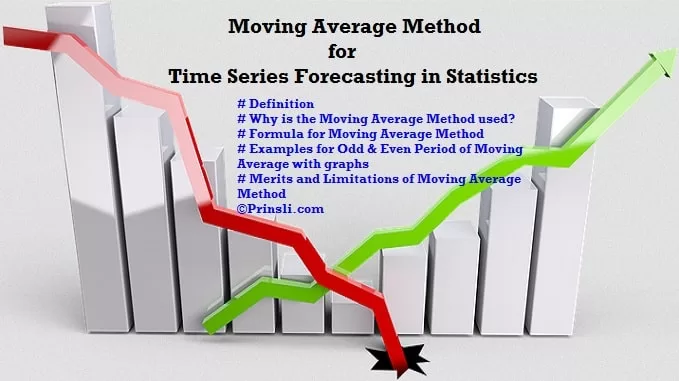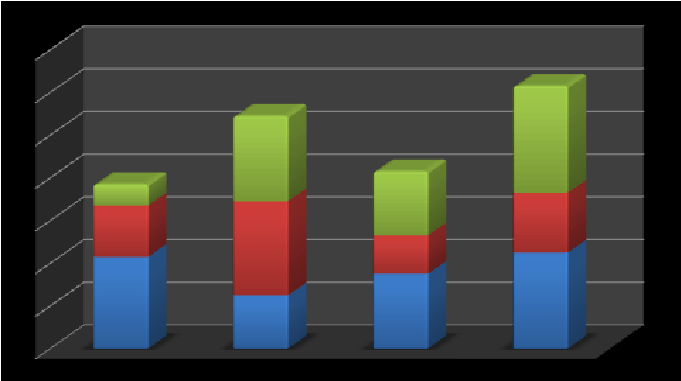
Moving Average Method for Time Series Forecasting
Moving Average Method for Time Series forecasting – The moving average is a statistical technique that is used to forecast long-term trends. The moving average is a simple and flexible process of trend measurement that is quite accurate under certain conditions. This method establishes a trend by using a series of averages covering overlapping periods of the data. The technique represents taking an average of a set of numbers in a given range while moving the range.
It is necessary to choose a period for the moving average when employing this method, such as a 3-year moving average, 5-year moving average, 6-year moving average, 8-year moving average, etc.
When a trend is to be determined by using the moving average method, the average value for a number of years (or months, or weeks) is secured, and this average is taken as the normal or trend value for the unit of time falling in the middle of the period covered in the calculation of the average. The result of averaging gives a smoother curve, which also reduces the influence of fluctuations that pull the annual figures away from the general trend.
Hence, the method of moving averages is another technique for obtaining trends. Starting with a certain number of time periods, the average is calculated and then successive averages are calculated by dropping the first of the values and including the next one.
Why is the Moving Average Method used? – The moving average method is popular and widely used in time-series forecasting due to its simplicity and flexibility. It does not require advanced mathematical knowledge, unlike other methods such as ARIMA or neural networks. This means that even persons with only basic statistical knowledge can use it to obtain reliable results.
The method of successively averaging, let’s say, three years data, and setting each average as the moving-average value of the central year in the group, should be applied throughout the entire series. The same process is used to calculate five-item, seven-item, or other moving averages: the average obtained each time is regarded as representative of the group’s middle period.
The choice of using a 5-year, 7-year, 9-year, or other moving average depends on how long of a period is required to completely eliminate the effects of the business cycle and unpredictable or erratic fluctuations. A good trend must be free from such fluctuations, and if the cycle has any definite periodicity, it is well to have the moving average cover one cycle period. For general business series, the necessary periods typically range between 3 and 10 years, while even longer periods are required for certain industries.
In the above discussion, the moving averages of the odd number of years were representatives of the middle years. If the moving average covers an even number of years, each average will still represent the period’s midpoint, but this midpoint will fall halfway between the two middle years.
For example, in the case of a 4-year moving average, each average represents a point halfway between the 2nd and 3rd years.
In this case, a second moving average can be used to ‘recentre’ the averages. In other words, if the first moving averages give averages centering halfway between the years, further two-point moving average will recentre the data exactly on the years.
However, this method is useful for estimating trends in a period of transition when the mathematical lines or curves might not be sufficient. This method provides a basis for testing other types of trends, even though the data are not such as to justify its use otherwise.
Formula for Moving Average Method –
The formula for the 3-yearly moving average will be:

Similarly, the formula for the 4-yearly moving average will be:

Similarly, the formula for the 5-yearly moving average will be:

Examples of Moving Averages Method –
♦ Case I – When the “Period of the Moving Average is Odd“, say, 3-yearly moving averages, 5-yearly moving averages, 7-yearly moving averages, etc.
Question 1 –
From the following data, estimate the trend values by taking 5-yearly moving averages –
Or
Calculate 5-yearly moving average trend for the time series given below –
Or
Fit a trend line by the method of five-yearly moving average to the following time series data.

Solution –
In this case, the period of the Moving Average is Odd (Because 5 years is an Odd Number of Years).
Calculation of 5-yearly Moving Average is shown in the following table –

The graph of the above data is given below –

♦ Case II – When the “Period of the Moving Average is Even“, say, 4-yearly moving averages, 6-yearly moving averages, 8-yearly moving averages, etc.
In this case, the moving total and moving average, which are located in the center of the time span from which they are computed, fall between two time periods. But this placement is inconvenient because the moving average would not correspond with the original time period. So, we synchronise moving averages with the original data. This process is known as centering, and it consists of taking a two-period moving average of the moving averages.
The moving averages can also be centered using a different method. If we want to calculate a 4-year moving average, for example, we will first take four-yearly totals and of these totals, we will again 2-yearly totals and divide these totals by 8.
Question 2 –
From the following data, estimate the trend values by taking 4-yearly moving averages –
Or
Calculate 4-yearly moving average trend for the time series given below –
Or
Fit a trend line by the method of four-yearly moving average to the following time series data.

Solution –
In this case, the period of the Moving Average is Even (Because 4 years is an Even Number of Years).
Calculation of 4-yearly Moving Average is shown in the following table –

The graph of the above data is given below –

Merits and Limitations of Moving Average Method –
Merits –
1. The Moving Average method is very simple in comparison to the least squares method.
2. It is a flexible method for measuring trend, because entire calculations need not change if a few more figures are added to the data. We just get some more trend values.
3. The fluctuations automatically disappear if the period of moving averages and the period of cyclical fluctuations coincide.
4. The moving average’s pattern is determined by the data’s trend and is unaffected by the choice of method of analysis used.
5. It can be put to utmost use when applied to series with strikingly irregular trends.
Limitations:
1. It is impossible to have a trend value for each and every year. As the period of the moving average increases, there is always an increase in the number of years for which trend values cannot be calculated and known.
For example, trend value cannot be obtained for the first two years and last two years of a five-year moving average, nor can it be obtained for the first three years and last three years of a seven-year moving average, and so on. But usually, values of the extreme years are of great interest.
2. There is no hard and fast rule (set formula) for choosing the period of a moving average, and one has to use his or her own judgment.
3. One of the main objectives of trend analysis is forecasting. But, since the moving average is not represented by a mathematical function, this main objective remains unfulfilled.
4. Although, theoretically, it is claimed that cyclical fluctuations are eliminated if the moving average’s period and the cycle’s period coincide, but in reality, cycles are not perfectly periodic.
5. Finally, if the trend situation is not linear, the moving average is either above or below the real sweep of the data.
The Moving Average method is appropriate for trend calculation only when:
i. The investigation’s purposes do not require current analysis or forecasting.
ii. The cyclical variations are regular in terms of period and amplitude.
iii. The trend is linear.
In reality, though, these circumstances are rarely true.
(Sources- Various books from College Library)
Copyrighted Material © 2019 - 2024 Prinsli.com - All rights reserved
All content on this website is copyrighted. It is prohibited to copy, publish or distribute the content and images of this website through any website, book, newspaper, software, videos, YouTube Channel or any other medium without written permission. You are not authorized to alter, obscure or remove any proprietary information, copyright or logo from this Website in any way. If any of these rules are violated, it will be strongly protested and legal action will be taken.





Be the first to comment